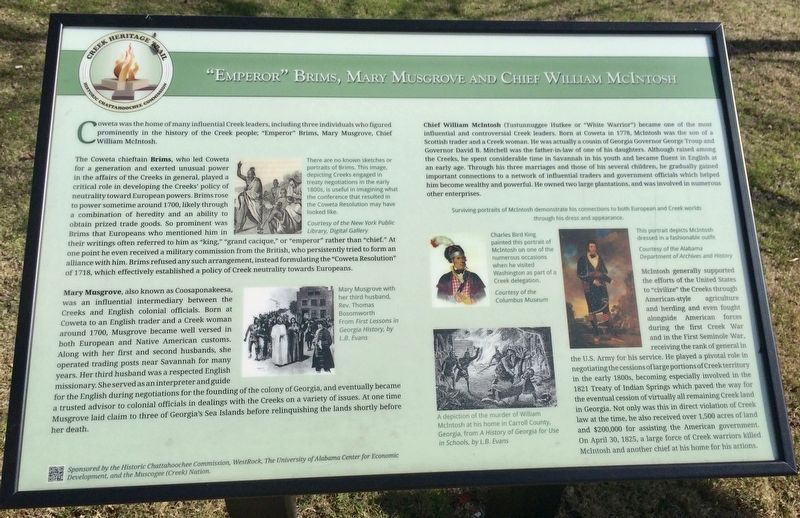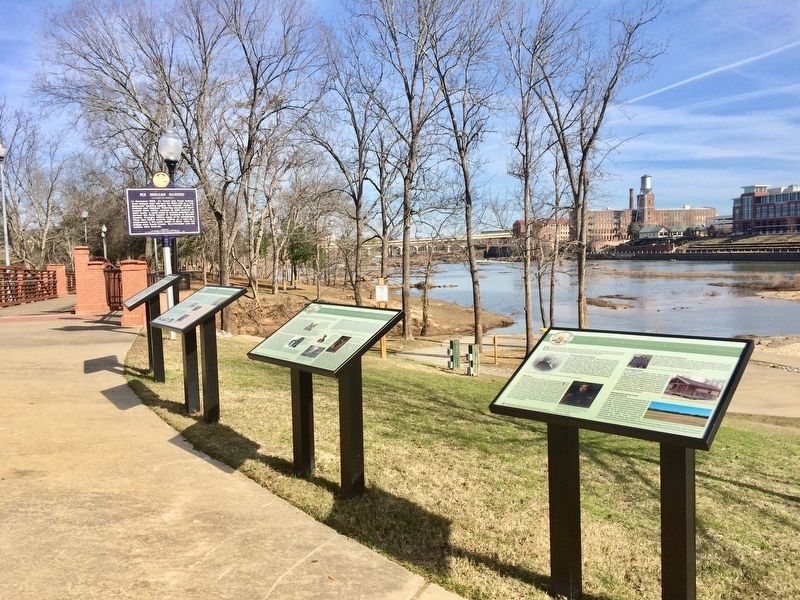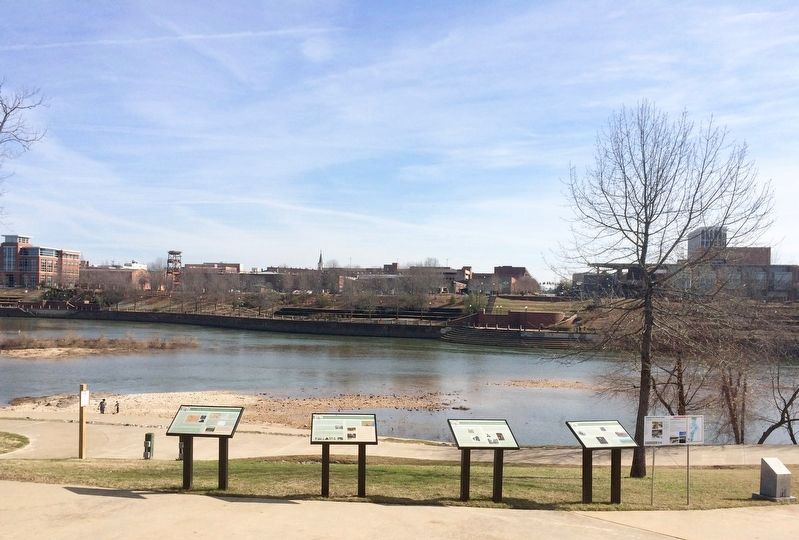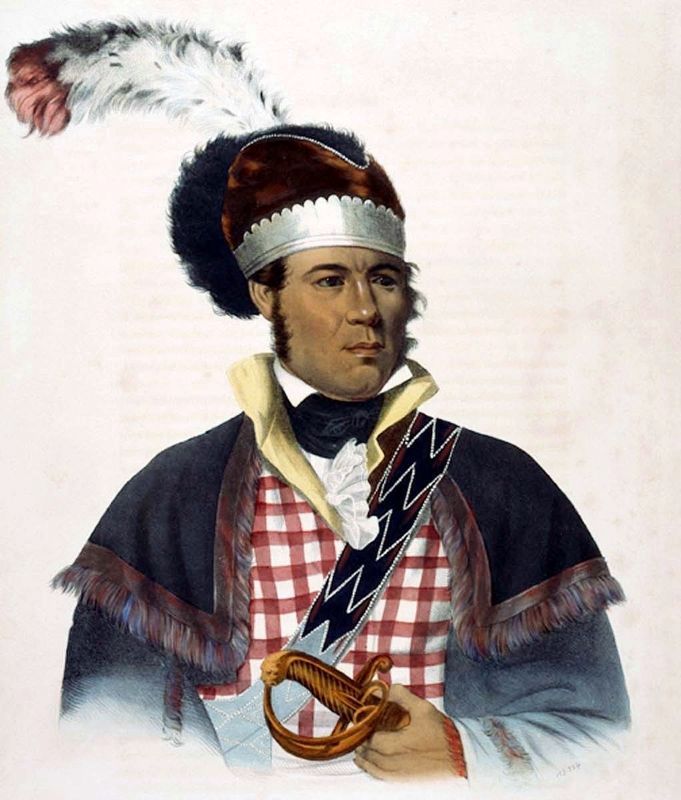Phenix City in Russell County, Alabama — The American South (East South Central)
"Emperor" Brims, Mary Musgrove and Chief William McIntosh
— Creek Heritage Trail —
Inscription.
Coweta was the home of many influential Creek leaders, including three individuals who figured prominently in the history of the Creek people; "Emperor” Brims, Mary Musgrove, Chief William McIntosh.
The Coweta chieftain Brims, who led Coweta for a generation and exerted unusual power in the affairs of the Creeks in general, played a critical role in developing the Creeks' policy of neutrality toward European powers. Brims rose to power sometime around 1700, likely through a combination of heredity and an ability to obtain prized trade goods. So prominent was Brims that Europeans who mentioned him in their writings often referred to him as "king," "grand cacique," or "emperor” rather than “chief.” At one point he even received a military commission from the British, who persistently tried to form an alliance with him. Brims refused any such arrangement, instead formulating the “Coweta Resolution” of 1718, which effectively established a policy of Creek neutrality towards Europeans.
Mary Musgrove, also known as Coosaponakeesa, was an influential intermediary between the Creeks and English colonial officials. Born at Coweta to an English trader and a Creek woman. around 1700, Musgrove became well versed in both European and Native American customs. Along with her first and second husbands, she operated trading posts near Savannah for many years. Her third husband was a respected English missionary. She served as an interpreter and guide for the English during negotiations for the founding of the colony of Georgia, and eventually became a trusted advisor to colonial officials in dealings with the Creeks on a variety of issues. At one time Musgrove laid claim to three of Georgia's Sea Islands before relinquishing the lands shortly before her death.
Chief William McIntosh (Tustunnuggee Hutkee or "White Warrior") became one of the most influential and controversial Creek leaders. Born at Coweta in 1778, McIntosh was the son of a Scottish trader and a Creek woman. He was actually a cousin of Georgia Governor George Troup and Governor David B. Mitchell was the father-in-law of one of his daughters. Although raised among the Creeks, he spent considerable time in Savannah in his youth and became fluent in English at an early age. Through his three marriages and those of his several children, he gradually gained important connections to a network of influential traders and government officials which helped him become wealthy and powerful. He owned two large plantations, and was involved in numerous other enterprises.
McIntosh generally supported the efforts of the United States to "civilize" the Creeks through American-style
agriculture and herding and even fought alongside American forces during the first Creek War and in the First Seminole War, receiving the rank of general in the U.S. Army for his service. He played a pivotal role in negotiating the cessions of large portions of Creek territory in the early 1800s, becoming especially involved in the 1821 Treaty of Indian Springs which paved the way for the eventual cession of virtually all remaining Creek land in Georgia. Not only was this in direct violation of Creek law at the time, he also received over 1,500 acres of land and $200,000 for assisting the American government. On April 30, 1825, a large force of Creek warriors killed McIntosh and another chief at his home for his actions.
[Photo captions]
Left middle: There are no known sketches or portraits of Brims. This image, depicting Creeks engaged in treaty negotiations in the early 1800s, is useful in imagining what the conference that resulted in the Coweta Resolution may have looked like. Courtesy of the New York Public Library, Digital Gallery
Left bottom: Mary Musgrove with her third husband, Rev. Thomas Bosomworth, from First Lessons in Georgia History, by L. B. Evans
Right Middle: Surviving portraits of McIntosh demonstrate his connections to both European and Creek worlds through his dress and appearance.
Middle
portrait: Charles Bird King painted this portrait of McIntosh on one of the numerous occasions when he visited Washington as part of a Creek delegation.
Courtesy of the Columbus Museum
Middle bottom: A depiction of the murder of William McIntosh at his home in Carroll County, Georgia, from A History of Georgia for Use in Schools, L.B. Evans
Right bottom: This portrait depicts McIntosh dressed in a fashionable outfit Courtesy of the Alabama Department of Archives and History
Erected 2015 by the Historic Chattahoochee Commission, WestRock, The University of Alabama Center for Economic Development and the Muscogee (Creek) Nation.
Topics. This historical marker is listed in these topic lists: Government & Politics • Native Americans • Wars, US Indian • Women. A significant historical date for this entry is April 30, 1825.
Location. 32° 27.888′ N, 84° 59.942′ W. Marker is in Phenix City, Alabama, in Russell County. Marker can be reached from the intersection of Dillingham Street and Brickyard Road (Route 61). Located on the north side of the Phenix City Amphitheater, along the Chattahoochee Riverwalk. Touch for map. Marker is at or near this postal address: 508 Dillingham Street, Phenix City AL 36867, United States of America. Touch for directions.
Other nearby markers. At least 8 other markers are within walking distance of this marker. Coweta and Northeastern Russell County: (here, next to this marker); Coweta: Center for International Diplomacy (here, next to this marker); The Creek Town of Coweta (here, next to this marker); Six Indians Hanged (a few steps from this marker); POW ✯ MIA Monument (within shouting distance of this marker); Confederates Set Fire To Lower Bridge (about 500 feet away, measured in a direct line); Military Service Walk (about 700 feet away in Georgia); Horace King (about 700 feet away). Touch for a list and map of all markers in Phenix City.
Also see . . .
1. Encyclopedia of Alabama on Emperor Brim. (Submitted on February 7, 2017, by Mark Hilton of Montgomery, Alabama.)
2. Wikipedia article on Mary Musgrove. (Submitted on February 7, 2017, by Mark Hilton of Montgomery, Alabama.)
3. Wikipedia article on William McIntosh. (Submitted on February 7, 2017, by Mark Hilton of Montgomery, Alabama.)
Credits. This page was last revised on November 2, 2019. It was originally submitted on February 7, 2017, by Mark Hilton of Montgomery, Alabama. This page has been viewed 1,342 times since then and 127 times this year. Photos: 1, 2, 3, 4. submitted on February 7, 2017, by Mark Hilton of Montgomery, Alabama.



